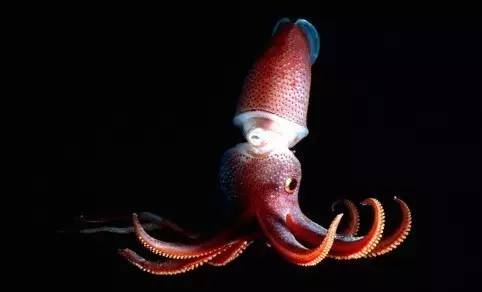
A deep-sea creature with a big eye and a small one. Recently, scientists have made new research.
there is no perfect symmetry in animals. It is normal to say that one eye is bigger and the other is smaller. But have you ever seen an animal with two eyes of such different sizes and styles:
this is a Histioteuthis heteropsis, because of its appearance, there is a common English name called "strawberry squid" (strawberry squid). Its two eyes are veritable "big and small eyes". Why? The most accepted hypothesis at present is that these two eyes have different functions .
= insert update
recently a new study on this small-eyed squid was published, so I decided to happily drag this article out and post it again (Hello).
the content of the new study is that previous speculations about the function of large and small eyes are supported by some behavioral evidence. To study exactly how these squid use these wonderful eyes, the researchers took a closer look at deep-sea video data collected over the past 30 years. A total of 152 scenes of the squid were filmed in these videos.
observe that these slow-swimming squid tend to maintain a "big head down" posture in the sea, and as I wrote earlier, their eyes do look in different directions: the big eyes continue to look up, while the small ones continue to look down. From this point of view, these two asymmetrical eyes do adapt to different functions in the process of evolution.
= after the update, you can continue to read the explanation written before =
these squid live in the deep sea, and the deep sea does not represent complete darkness. On the one hand, there is a glimmer of light from above, on the other hand, many creatures can glow. Here, the eyes are actually very useful. Scientists believe that these two different eyes capture different light information: the big eyes are responsible for looking up and observing where the shadow appears in the upper glimmer background, which means that there are other animals moving there. On the other hand, the little one's eyes look at the darker places below to see where dots of bioluminescence appear, and prey can be found in this way.
these two eyes differ not only in size, but also in their structural features: the big eye has a tubular structure and has a "filter" to absorb blue light (so we will see that the big eye is yellow).
this is also helpful to better implement its functions. Those creatures watched by squid from below (such as some fish) also have a defense to hide themselves, that is, "Counter-illumination". In other words, they also emit some glimmer on their belly to counteract the shadow caused by blocking the shimmer above, thus hiding themselves in the background. The hiding is not perfect (the color of the light is greener), and after absorbing blue light through the "filter", the large and small-eyed squid can better distinguish these creatures from the background.
A schematic diagram of luminous vanishing:
in fact, this kind of squid also has the ability to glow and vanish. After all, there are other predators watching them in deeper places.
Buy our halter wedding dresses and enjoy the combination of their high quality and superior material. Find that perfect dress, it will stay timeless and trendy season after season.
the concept of Counter-illumination also appears in the lyrics of the initial sound "Deep-sea Girl". I wonder if you have ever heard of
(here "Counter-illumination" means "deep sea maiden". In fact, it also expresses the meaning of concealment and self-defense. I like this song very much.
finally, I would like to say that this kind of creature with big and small eyes is so friendly to our handicapped party that we can never draw symmetrical eyes, so I immediately decided to give ta a personal _ (: symmetry "∠) _
this article reference: Absurd Creature of the Week: The Squid That Looks Like a Bee Stung It in the Eyeball
Two eyes for two purposes: in situ evidence for asymmetric vision in the cockeyed squids Histioteuthis heteropsis and Stigmatoteuthis dofleini
to read the original text. Learn more about the light and shadow games of deep-sea creatures.